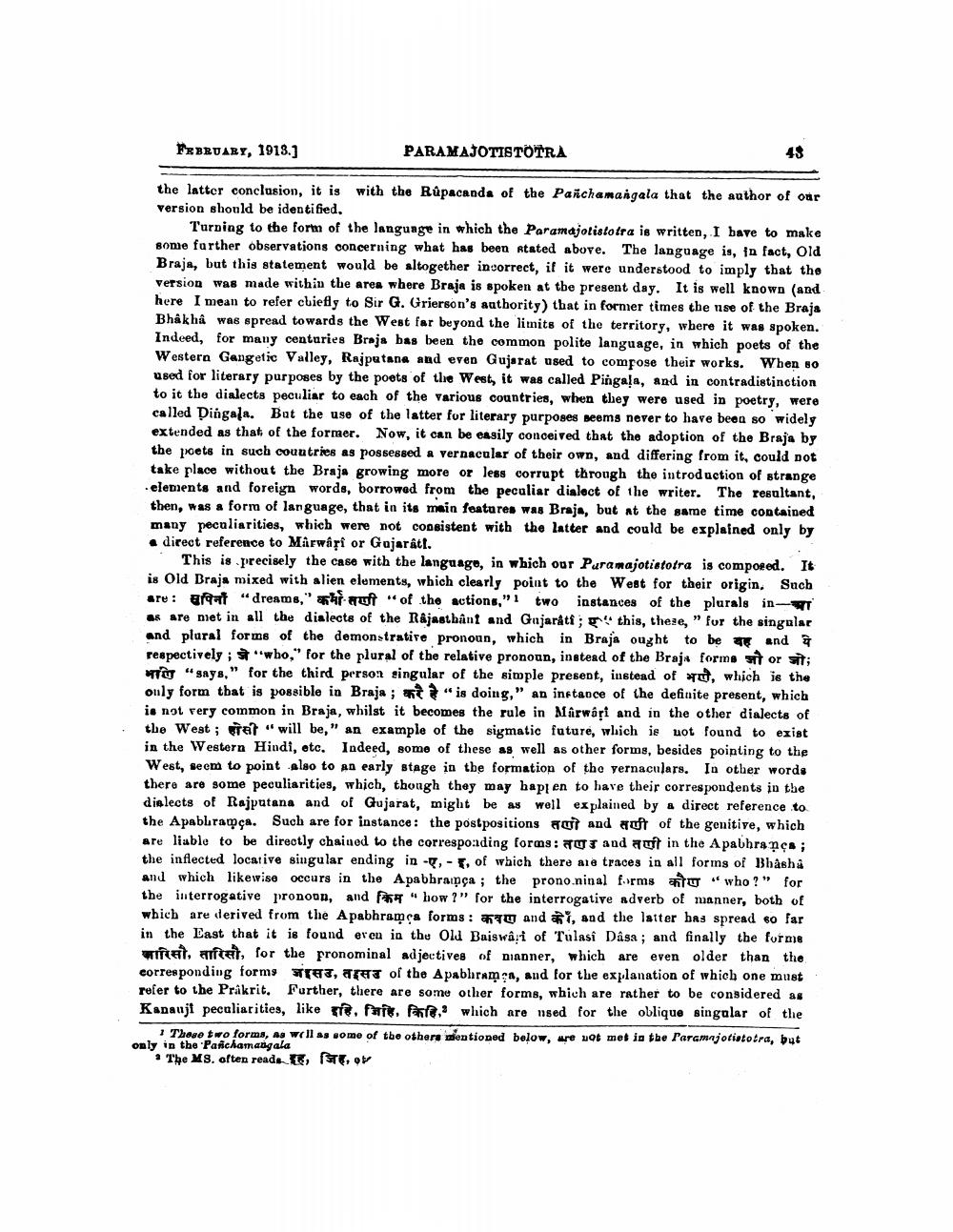________________
FEBRUARY, 1913.)
PARAMAJOTISTOTRA
the latter conclusion, it is with the Rupacanda of the Panchamangala that the author of oar version should be identified,
Turning to the form of the language in which the Paramajolistotra is written, I have to make some further observations concerning what has been stated above. The language is, in fact, Old Braja, but this statement would be altogether incorrect, if it were understood to imply that the version was made within the area where Braja is spoken at the present day. It is well known (and here I mean to refer chiefly to Sir G. Grierson's authority) that in former times the nse of the Braja Bhakhê was spread towards the West far beyond the limits of the territory, where it was spoken. Indeed, for many centuries Braja bas been the common polite language, in which poets of the Western Gangetic Valley, Rajputana and even Gujarat used to compose their works. When so used for literary purposes by the poets of the West, it was called Pingala, and in contradistinction to it the dialects peculiar to each of the various countries, when they were used in poetry, were called Dingala. But the use of the latter for literary purposes seems never to have been so widely extended as that of the former. Now, it can be easily conceived that the adoption of the Braja by the poets in such countries as possessed a vernacular of their own, and differing from it, could not take place without the Braja growing more or less corrupt through the introduction of strange elements and foreign words, borrowed from the peculiar dialect of the writer. The resultant, then, was a form of language, that in its main features was Braja, but at the same time contained many peculiarities, which were not consistent with the latter and could be explained only by direct reference to Marwari or Gajarätt.
This is precisely the case with the language, in which our Puramajotietotra is compored. It is Old Braja mixed with alien elements, which clearly point to the West for their origin. Such are: argat "dreams," hr auf " of the actions," i two instances of the plurals in as are met in all the dialects of the Rajasthant and Gujarati; "this, there," for the singular and plural forms of the demonstrative pronoun, which in Braja ought to be and respectively ; $wbo," for the plural of the relative pronoun, instead of the Braja forms or ;
TU “gays," for the third persoa singular of the simple present, instead of you, which is the only form that is possible in Braja ; * " is doing," an instance of the definite present, which is not very common in Braja, whilst it becomes the rule in Marwori and in the other dialects of the West; Tat"will be," an example of the sigmatic future, which ie uot found to exist in the Western Hindi, etc. Indeed, some of these as well as other forms, besides pointing to the West, seem to point also to an early stage in the formation of the vernaculars. In other words there are some peculiarities, which, though they may hapen to have their correspondents in the dialects of Rajputana and of Gujarat, might be as well explained by a direct reference to the Apabliramça. Such are for instance: the postpositions Hot and aut of the genitive, which are liable to be directly chained to the correspoading forms: YUT and out in the Apabhrança; the inflected locative singular ending in -, -, of which there are traces in all forms of Bhasha and which likewise occurs in the Apabbraipça; the prono.ninal forms U " who?" for the interrogative pronoon, and how ?" for the interrogative adverb of manner, both of which are derived from the Apabhramça forms: ayu and , and the latter has spread so far in the East that it is found eren in the Old Baiswari of Tulasi Dasa; and finally the forme w at, acet, for the pronominal adjectives of nianner, which are even older than the corresponding forms 3, TH of the Apabhrama, and for the explanation of which one must refer to the Prakrit. Further, there are some other forms, which are rather to be considered as Kanauji peculiarities, like , faft, Pane, which are used for the oblique singular of the
1 These two forms, as well as some of the other mentioned below, are not met in the Paramajoristotra, but only in the Panchamangala
· The MS. often reada , (TE, OV




